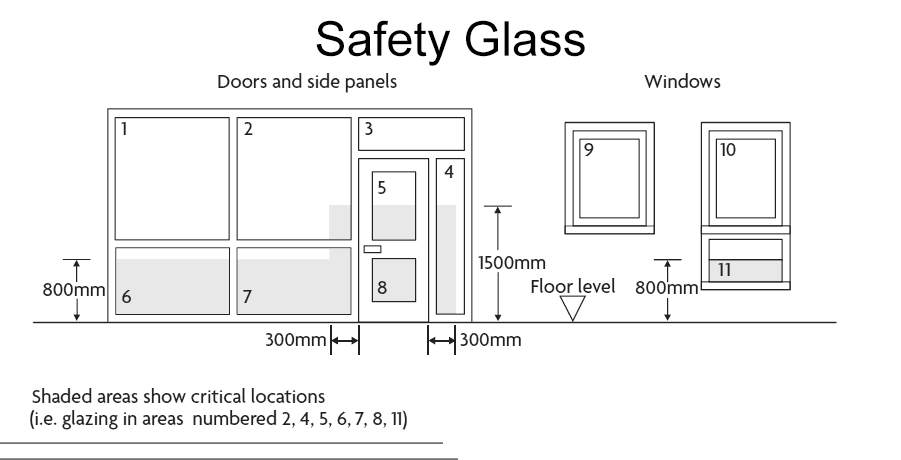Safety Glazing & Fire Rated Glass
What is safety glazing ?
Safety glazing is the process used to make glass less susceptible to breakage, and less dangerous when broken. Although there are several different types of safety glazing, the two most common types used are toughened and laminated glass.
Toughened Glass
Toughened glass is a safety glass up to five times more stronger than ordinary glass of the same thickness.
Laminated Glass
Laminated glass is produced by combining two or more sheets of glass with one or more plastic interlayers.
Fire glass
Fire rated glass products are especially manufactured, to be able to withstand high temperatures, prevent the spread of flames, fire and smoke.
Toughened glass
Toughened glass is a safety glass up to five times more stronger than ordinary glass of the same thickness.
Because of its increased strength, it meets Safety Standards for glass subjected to accidental human impact at the highest level of severity.
Toughened glass is made from normal float glass. It is cut to the required size, then heated in a furnace, to a temperature over 600c. The hot glass is then rapidly cooled.
When broken, toughened glass shatters into small, blunt-edged pieces, reducing the risk of personal injury.
Benefits Of Toughened Glass
Strength
Sound reduction
UV protection
Heat resistance
Impact resistance
Durability
Versatility
Where Used
Kitchen splash backs
Work tops
Doors Internal and External
Doors internal & external
Windows
Stairways
Patio Doors
Low level glazing
Offices
Schools
Gym
Frame less shop fronts
Partitions
Laminated Glass
Laminated glass is produced by combining two or more sheets of glass with one or more plastic interlayers. The performance can therefore be varied by changing the number of each of the glass panels and the interlayers ( PVB ) used.
The interlayers ensure the integrity of the glass, by holding the broken pieces in place should any damage occur.
Benefits Of Laminated glass
Safety
Security ( Anti Bandit )
Sound reduction
UV control
Low visible distortion
Solar energy control
Durability
Protection from weather and natural disasters
Where Used
Skylights
Roofs
Shop fronts
Doors internal & external
Windows
Schools
Partitions
Sports halls
Homes
Ensuring you have the right safety glazing in your home or business, is essential to meet strict codes and keep your building and occupants safe.
Our experienced team will advise you of safety regulations relating to the use of glass in the home of commercial building. In the updated British Standard BS6262 part 4 1994 code of practice for glazing for building, the main points addressed is “critical locations”.
All defined locations in buildings must be safe.
In the diagrams below, the shaded areas indicate window, doors and side panels most likely to be subject to an accident including human impact.

All the glass in the total or partial shaded areas, must meet the safety standards of British Standard 6206.
The glass must be laminated, toughened, wired or have a plastic safety film applied.
Small panes no wider than 250mm, ordinary 6mm annealed float glass may be used , providing the overall area of each pane does not exceed 0.5m2.
Although it may be considered acceptable to use float glass in smaller panes , we would always advise using safety glass, regardless how small the area.
Please Note.
All information is provided for guidance and reference purposes only.
Fire Glass
What is fire glass ?
Fire rated glass products are especially manufactured, to be able to withstand high temperatures, prevent the spread of flames, fire and smoke
Do you require fire rated glass in your home or commercial property ?
We can provide a complete installation service of fire rated products, that fully comply with British Standards to improve fire safety within your property.
A wide range of fire glass types are produced, offering increased levels of protection. Each product is measured in periods of time and in terms of integrity and insulation, or integrity only.
The difference between integrity & insulation
Integrity Glass
Integrity glass acts as a barrier against flames and hot gases.
Insulation Glass
Insulation glass limits the transfer of heat.
All fire resistant glass must be correctly installed , with the appropriate glazing materials, into a suitable fire resistant approved frame (supplied by others).
Our wide range includes
Monolithic clear wired
Monolithic textured wired
7.2mm clear Pyroguard
7.2mm obscure Pyroguard
11.4mm Pyroguard
12mm Pyrobelite plus others
Where Used
Fire doors
Emergency exits
Fire screens
Schools
Hospitals
Office / corridors
Homes
British Standard 6206
All the glass in the total or partial shaded areas, must meet the safety standards of British Standard 6206.
The glass must be laminated, toughened, wired or have a plastic safety film applied.
Small panes no wider than 250mm, ordinary 6mm annealed float glass may be used , providing the overall area of each pane does not exceed 0.5m2.
Although it may be considered acceptable to use float glass in smaller panes , we would always advise using safety glass, regardless how small the area.
Please Note
All information is provided for guidance and reference purposes only.
